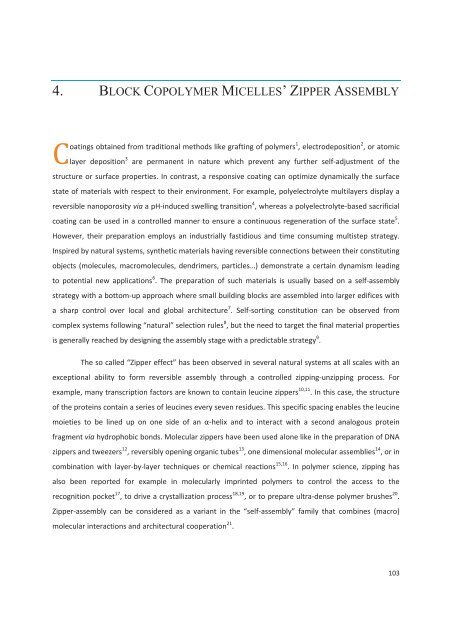4(%3)3 - Ecole nationale supérieure de chimie de Montpellier
4(%3)3 - Ecole nationale supérieure de chimie de Montpellier
4(%3)3 - Ecole nationale supérieure de chimie de Montpellier
You also want an ePaper? Increase the reach of your titles
YUMPU automatically turns print PDFs into web optimized ePapers that Google loves.
4. BLOCK COPOLYMER MICELLES’ ZIPPER ASSEMBLYCoatings obtained from traditional methods like grafting of polymers 1 , electro<strong>de</strong>position 2 , or atomiclayer <strong>de</strong>position 3are permanent in nature which prevent any further self-adjustment of thestructure or surface properties. In contrast, a responsive coating can optimize dynamically the surfacestate of materials with respect to their environment. For example, polyelectrolyte multilayers display areversible nanoporosity via a pH-induced swelling transition 4 , whereas a polyelectrolyte-based sacrificialcoating can be used in a controlled manner to ensure a continuous regeneration of the surface state 5 .However, their preparation employs an industrially fastidious and time consuming multistep strategy.Inspired by natural systems, synthetic materials having reversible connections between their constitutingobjects (molecules, macromolecules, <strong>de</strong>ndrimers, particles…) <strong>de</strong>monstrate a certain dynamism leadingto potential new applications 6 . The preparation of such materials is usually based on a self-assemblystrategy with a bottom-up approach where small building blocks are assembled into larger edifices witha sharp control over local and global architecture 7 . Self-sorting constitution can be observed fromcomplex systems following “natural” selection rules 8 , but the need to target the final material propertiesis generally reached by <strong>de</strong>signing the assembly stage with a predictable strategy 9 .The so called “Zipper effect” has been observed in several natural systems at all scales with anexceptional ability to form reversible assembly through a controlled zipping-unzipping process. Forexample, many transcription factors are known to contain leucine zippers 10,11 . In this case, the structureof the proteins contain a series of leucines every seven residues. This specific spacing enables the leucine -helix and to interact with a second analogous proteinfragment via hydrophobic bonds. Molecular zippers have been used alone like in the preparation of DNAzippers and tweezers 12 , reversibly opening organic tubes 13 , one dimensional molecular assemblies 14 , or incombination with layer-by-layer techniques or chemical reactions 15,16 . In polymer science, zipping hasalso been reported for example in molecularly imprinted polymers to control the access to therecognition pocket 17 , to drive a crystallization process 18,19 , or to prepare ultra-<strong>de</strong>nse polymer brushes 20 .Zipper-assembly can be consi<strong>de</strong>red as a variant in the “self-assembly” family that combines (macro)molecular interactions and architectural cooperation 21 .103











